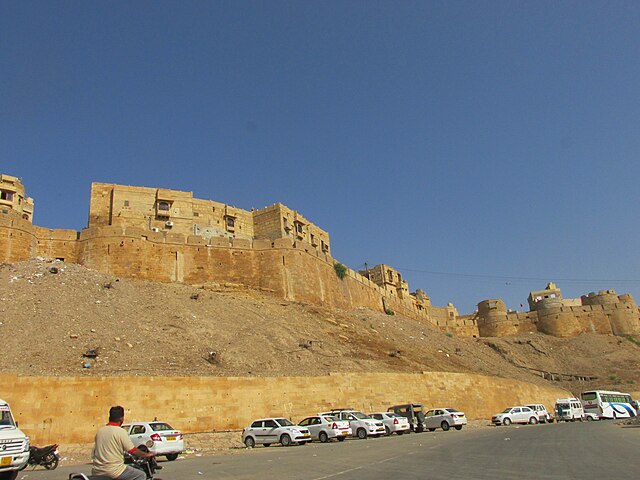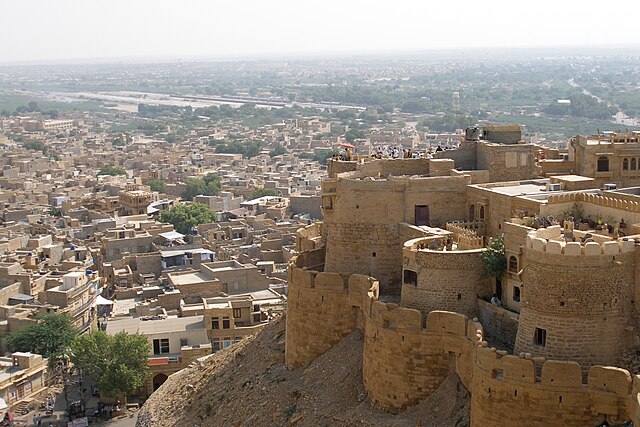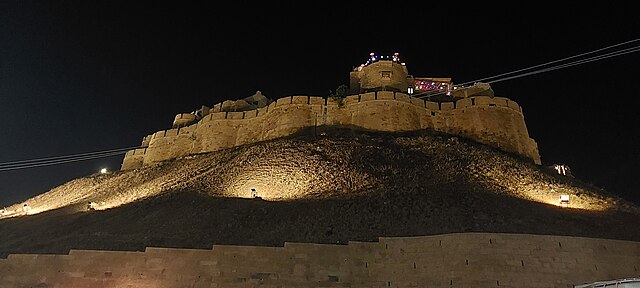Ever wondered what it’s like to wander through a golden city in the heart of the Thar Desert? Jaisalmer, Rajasthan’s shimmering jewel, is as much about its climate as it is about its forts and dunes. The temperature here swings like a pendulum, from scorching summer highs to chilly winter nights, shaping every adventure you’ll have. Whether you’re planning a camel safari or a stroll through the Jaisalmer Fort, understanding Jaisalmer’s temperature is key to making your trip unforgettable. Let’s dive into the nitty-gritty of this desert city’s weather and how it sets the stage for your golden getaway!
Understanding Jaisalmer’s Desert Climate
Jaisalmer sits smack in the middle of the Thar Desert, and its climate is as dramatic as the landscape. Think of it like a moody artist—sometimes blazing with intensity, sometimes cool and mysterious. The city experiences an arid climate, with extreme temperatures, low humidity, and minimal rainfall. This means you’re in for clear skies most of the year, but you’ll need to brace for some wild temperature swings. From sizzling summers to crisp winters, Jaisalmer’s weather is a character in its own right, influencing everything from what you pack to when you visit.
What Makes Jaisalmer’s Weather Unique?

The Thar Desert gives Jaisalmer its unique vibe. Unlike coastal or mountainous regions, this desert city deals with intense heat during the day and surprising chills at night. The sandy terrain absorbs heat fast, making daytime feel like you’re walking on a giant frying pan, but it cools off quickly after sunset. Rainfall? Almost a myth here, with an annual average of just 150-200 mm. This arid environment creates a stark, beautiful contrast—golden sands under a relentless sun, dotted with starry nights. Ready to see how these conditions play out across the seasons?
The Role of the Thar Desert
The Thar Desert is like Jaisalmer’s thermostat, cranking up the heat and keeping things bone-dry. Its vast expanse of sand dunes amplifies daytime temperatures, often pushing them above 40°C (104°F) in summer. At night, the lack of moisture means heat escapes quickly, dropping temps significantly. This desert also shields Jaisalmer from monsoon rains that drench other parts of India, giving the city its signature arid charm. It’s like living in a postcard where the weather paints the scene as much as the architecture.
Summer in Jaisalmer: The Fiery Season
Summer in Jaisalmer, from March to June, is not for the faint-hearted. Imagine stepping into an oven—that’s the vibe. Daytime temperatures soar between 38°C and 45°C (100°F to 113°F), sometimes flirting with 50°C (122°F) in May, the hottest month. The sun blazes down, turning the golden sandstone of Jaisalmer Fort into a radiant beacon. Humidity stays low, around 20-30%, which makes the heat feel dry but relentless. If you’re visiting in summer, you’ll need to channel your inner desert warrior to explore the city’s treasures.
Surviving the Summer Heat
Think summer in Jaisalmer sounds daunting? It can be, but with the right prep, you’ll manage just fine. Stick to early mornings or late afternoons for sightseeing—think 6 AM strolls through Patwon Ki Haveli or sunset views from Gadisar Lake. Hydration is your best friend, so carry a water bottle like it’s your lifeline. Lightweight, loose clothing in breathable fabrics like cotton will keep you comfortable, and don’t forget a wide-brimmed hat or umbrella for shade. Many locals swear by lassi, a cooling yogurt drink, to beat the heat. Sound refreshing?
Indoor Activities for Summer Visitors
When the sun’s at its peak, Jaisalmer’s indoor attractions are a godsend. The Jaisalmer Fort’s cool stone interiors offer respite, with its museums and Jain temples keeping you engaged. Havelis like Salim Singh Ki Haveli, with their shaded courtyards and intricate designs, are perfect for midday exploration. You can also dive into local culture at the Desert Culture Centre and Museum, where exhibits on Rajasthani life keep you out of the heat. It’s like stepping into a time capsule while staying cool as a cucumber.
Monsoon in Jaisalmer: A Rare Treat
Monsoon season, from July to September, is a bit of a misnomer in Jaisalmer. Rain is scarce, with only a few showers sprinkling the desert—think 50-100 mm total. Temperatures drop slightly, hovering between 30°C and 38°C (86°F to 100°F), but humidity can make it feel stickier. The desert blooms subtly, with patches of green adding a surreal touch to the golden landscape. It’s like the desert is teasing you with a hint of lushness before returning to its arid ways.
What to Expect During Monsoon
Don’t expect a tropical downpour in Jaisalmer’s monsoon. The occasional drizzle might cool things off, but the city stays mostly dry. This makes it a decent time for outdoor adventures like camel safaris, as the temperatures are more bearable. The skies often clear up quickly, offering dramatic photo ops of the fort against stormy clouds. Just pack a light raincoat and sturdy shoes in case of rare muddy patches. Ever seen a desert under a cloudy sky? It’s a sight to behold!
Winter in Jaisalmer: The Golden Season

Winter, from October to February, is Jaisalmer’s sweet spot. Daytime temperatures range from 20°C to 28°C (68°F to 82°F), perfect for exploring without breaking a sweat. Nights get chilly, dipping to 5°C to 10°C (41°F to 50°F), especially in December and January. The clear skies and mild weather make this the peak tourist season, with the Desert Festival in February adding a cultural cherry on top. It’s like Jaisalmer rolls out the red carpet for visitors during winter.
Why Winter is the Best Time to Visit
Winter in Jaisalmer is like a warm hug from the desert. The pleasant days let you wander through the fort, havelis, and bazaars without melting. Desert camping at Sam Sand Dunes is magical, with cool nights perfect for bonfires and stargazing. The Desert Festival, with its camel races and folk performances, is a winter highlight that draws crowds from around the world. If you’re dreaming of a hassle-free Jaisalmer adventure, winter’s your season. Who wouldn’t want to sip masala chai under a starry desert sky?
Packing for Winter in Jaisalmer
Packing for Jaisalmer’s winter is all about layers. Days are warm, so light clothing works, but nights demand sweaters, jackets, and maybe a shawl for that authentic Rajasthani vibe. Comfortable walking shoes are a must for exploring the fort’s cobbled lanes or trekking the dunes. Toss in some sunscreen—yes, even in winter, the desert sun is no joke. A scarf or hat can double as a stylish accessory and protection from the occasional dusty breeze. Ready to bundle up for a desert night?
Temperature Extremes: Day vs. Night
One of Jaisalmer’s quirks is its dramatic temperature swings between day and night. In summer, you might sweat through 45°C (113°F) days only to shiver at 20°C (68°F) nights. Winter sees 25°C (77°F) days drop to near-freezing nights. This rollercoaster is due to the desert’s low humidity and sandy terrain, which don’t retain heat. It’s like the desert can’t decide whether to roast you or freeze you! Always pack for both extremes, no matter the season.
How Temperature Shapes Jaisalmer’s Culture
Jaisalmer’s climate isn’t just weather—it’s a way of life. The scorching summers and chilly winters have shaped everything from architecture to cuisine. Havelis with their thick sandstone walls keep interiors cool in summer and warm in winter. Local dishes like ker sangri, made from desert plants, reflect the need for food that lasts in harsh conditions. Even festivals like the Desert Festival are timed for winter, when the weather welcomes visitors. It’s like the desert and its people have a silent pact to thrive together.
Festivals and Weather: A Perfect Pair
Jaisalmer’s festivals are cleverly synced with its climate. The Desert Festival in February takes advantage of winter’s mild days, letting visitors enjoy camel races and folk dances without wilting. Smaller events, like local fairs, often pop up post-monsoon when the desert looks its freshest. These celebrations are like Jaisalmer’s way of saying, “Come enjoy my best weather!” They’re a chance to see the city’s culture shine under perfect conditions.
Tips for Traveling to Jaisalmer Year-Round

No matter when you visit, Jaisalmer’s temperature demands a game plan. Summer travelers should focus on indoor sites and early outings, while winter visitors can roam freely but need warm layers for nights. Monsoon season is quieter, so book desert camps early for better deals. Always carry water, sunglasses, and sunscreen—the desert sun doesn’t mess around. Local guides can help you navigate the weather, sharing tips on the best times for dune sunsets or fort visits. Ready to conquer Jaisalmer’s climate?
Choosing the Right Accommodation
Your stay in Jaisalmer can make or break your trip, especially with the temperature swings. In summer, opt for hotels with air conditioning or heritage havelis with naturally cool interiors. Winter calls for cozy desert camps or boutique hotels with heating options. Many desert camps offer luxury tents with fans or heaters, depending on the season. It’s like choosing between a cool oasis or a warm cocoon—either way, you’ll feel right at home in Jaisalmer’s golden embrace.
Climate’s Impact on Jaisalmer’s Tourism
Jaisalmer’s temperature plays a starring role in its tourism. Winter sees a flood of visitors, with hotels and camps booked months in advance. Summer is quieter, offering budget-friendly deals but requiring heat-savvy planning. Monsoon brings a niche crowd, drawn by the desert’s rare greenery. The weather shapes not just when you visit but how you experience the city—think winter camel rides versus summer museum hops. It’s like Jaisalmer’s climate is your travel guide, nudging you toward the best experiences.
Conclusion
Jaisalmer’s temperature is more than just numbers on a weather app—it’s the pulse of the Golden City. From blistering summer days to crisp winter nights, the climate shapes every adventure, from dune safaris to fort explorations. Whether you’re chasing the Desert Festival’s winter buzz or seeking a quiet monsoon escape, understanding Jaisalmer’s weather unlocks the best of this desert gem. So, pack smart, plan for the season, and let Jaisalmer’s golden sands and starry skies sweep you away. Ready to brave the desert’s whims?
FAQs
1. What’s the hottest month in Jaisalmer?
May is typically the hottest, with daytime temperatures often hitting 45°C (113°F) or higher. Early mornings and indoor activities are your best bet.
2. Does Jaisalmer get cold in winter?
Yes, nights can dip to 5°C to 10°C (41°F to 50°F) in December and January, so pack warm layers for evening outings or desert camping.
3. Is monsoon a good time to visit Jaisalmer?
Monsoon (July to September) is quieter, with milder temperatures and occasional drizzle. It’s great for fewer crowds and unique desert views.
4. How do I stay cool in Jaisalmer’s summer?
Wear loose, light clothing, stay hydrated, use sunscreen, and plan outdoor activities for early mornings or late afternoons to avoid peak heat.
5. Does Jaisalmer’s weather affect desert camping?
Absolutely! Winter is ideal for camping with cool nights, while summer requires well-ventilated tents. Monsoon camping is rare but offers a unique vibe.

